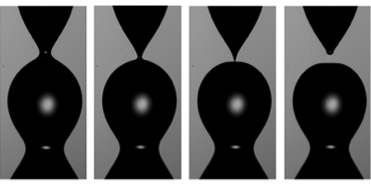Capturing Droplets by the Neck
The only truly universal characteristic of drippy faucets may be that they keep people awake at night, but as reported in Physical Review E, experimentalists have confirmed a prediction that the conical shape of a liquid jet just before a droplet breaks off from it always has the same angle.
In 1996, John Lister and colleagues at the University of Cambridge, UK, simulated the shape of a pendant drop of low-viscosity liquid over time. No matter what shape they started with, the thread of liquid suspending the drop would eventually neck into a cone with an internal angle of 36.2 degrees. The shape of the neck was self-similar, meaning it would look the same if observed at many different magnifications.
Teaming up with Lister, Jose Castrejón-Pita and his group, also at Cambridge, equipped a microscope with a high-speed camera to study the rapidly changing shape of liquid thread suspending a liquid drop as it approached the breakoff point. With 2 microsecond exposures spaced between 2 and 20 microseconds apart, the camera imaged both ethanol and water slowly emerging from a 5 mm nozzle and captured the shape of the neck right before and after the droplet fell. The angle they measured, 36.0±0.8 degrees, was the same regardless of if the neck was suspending the droplet or if it formed as a thread of liquid separated into multiple droplets.
Castrejón-Pita et al.’s experiments provide a check on the numerical simulations that describe droplet formation, a phenomenon with an important industrial application in inkjet printers. – Jessica Thomas





